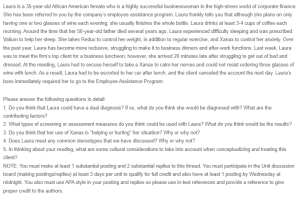Dual Diagnosis – Alcohol Use and Anxiety Disorders Case Study
Dual Diagnosis Possibility and Potential Diagnosis
Laura, a 35-year-old African American businesswoman in corporate finance, might have a dual diagnosis. She probably has Alcohol Use Disorder (AUD) because she drinks an entire bottle of wine at night even if she does not intend to do so. Further, she uses Xanax for anxiety and avoiding social contact; she may have Generalized Anxiety Disorder (GAD). The possible risk factors include high job stress from her career, her father’s death, and genetic influence.
Screening and Assessment Measures
As for the identification of a generalized diagnosis of Laura’s condition, using the Alcohol Use Disorders Identification Test (AUDIT) or the Drug Abuse Screening Test (DAST-20) would be helpful. One could use a diagnostic interview to describe her possible anxiety. Using these tools, it would reasonably expect substantial symptoms of alcohol dependence and symptoms of the probable anxiety disorder that might have been worsened by her use of Xanax and Valium (Chen et al., 2024).
Impact of Xanax Use
Prescribed Xanax has seemed to be harming Laura rather than being beneficial. Though Xanax can help to reduce anxiety for a short time, prolonged use of the drug might cause dependence on the medicine, development of tolerance to the drug, and even a worsening of anxiety as a result of the “rebound effect.” The use of Xanax and alcohol is particularly hazardous as they are both CNS depressants, raising the likelihood of an overdose, and they affect higher mental and motor functions (George & Tripp, 2019).
Stereotypes and Cultural Considerations
In this respect, it is possible to state that Laura corresponds to the traditional image of a high-profile employee who tends to use substances in order to manage her work-related stress, which means that people can easily overlook her condition, considering it as relatively mild and far from the truth. Cultural factors involve/her poor mental health and substance use disorder perception in the African American population, which hinders her from seeking help. Further, she is not only a working woman but a successful businesswoman, hence the likelihood of carrying around the feeling of having to be a strong wall, and this, as suggested by Kim & Jung (2022), may hinder her from seeking help for her problems.
References
Chen, Y., Wills, L., Wise, H., Erford, B. T., & Yao, R. (2024). Psychometric synthesis of the Alcohol Use Disorders Identification Test (AUDIT). Journal of Counseling and Development. https://doi.org/10.1002/jcad.12531
George, T., & Tripp, J. (2019, October 11). Alprazolam. Nih.gov; StatPearls Publishing. https://www.ncbi.nlm.nih.gov/books/NBK538165/
Kim, J., & Jung, H.-S. (2022). The Effect of Employee Competency and Organizational Culture on Employees’ Perceived Stress for Better Workplace. International Journal of Environmental Research and Public Health, 19(8), 4428. ncbi. https://www.ncbi.nlm.nih.gov/pmc/articles/PMC9032235/
ORDER A PLAGIARISM-FREE PAPER HERE
We’ll write everything from scratch
Question
Laura is a 35-year-old African American female who is a highly successful businesswoman in the high-stress world of corporate finance. She has been referred to you by the company’s employee assistance program. Laura frankly tells you that although she plans on only having one or two glasses of wine each evening; she usually finishes the whole bottle. Laura drinks at least 3-4 cups of coffee each morning. Around the time that her 50-year-old father died several years ago, Laura experienced difficulty sleeping and was prescribed Valium to help her sleep. She takes Redux to control her weight, in addition to regular exercise, and Xanax to control her anxiety. Over the past year, Laura has become more reclusive, struggling to make it to business dinners and after-work functions. Last week, Laura was to meet the firm’s top client for a business luncheon; however, she arrived 20 minutes late after struggling to get out of bed and dressed. At the meeting, Laura had to excuse herself to take a Xanax to calm her nerves and could not resist ordering three glasses of wine with lunch. As a result, Laura had to be escorted to her car after lunch, and the client canceled the account the next day. Laura’s boss immediately required her to go to the Employee Assistance Program.

Dual Diagnosis – Alcohol Use and Anxiety Disorders Case Study
Please answer the following questions in detail:
1. Do you think that Laura could have a dual diagnosis? If so, what do you think she would be diagnosed with? What are the contributing factors?
2. What types of screening or assessment measures do you think could be used with Laura? What do you think would be the results?
3. Do you think that her use of Xanax is “helping or hurting” her situation? Why or why not?
4. Does Laura meet any common stereotypes that we have discussed? Why or why not?
5. In thinking about your reading, what are some cultural considerations to take into account when conceptualizing and treating this client?
NOTE: You must make at least 1 substantial posting and 2 substantial replies to this thread. You must participate in the Unit discussion board (making postings/replies) at least 3 days per unit to qualify for full credit and also have at least 1 posting by Wednesday at midnight. You also must use APA style in your posting and replies so please use in-text references and provide a reference to give proper credit to the authors.

